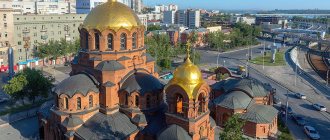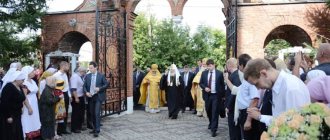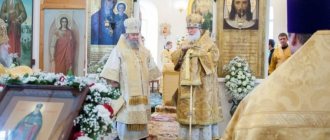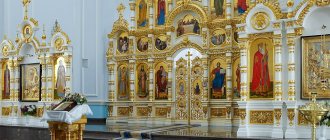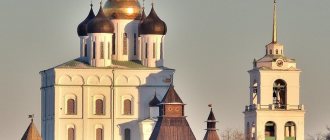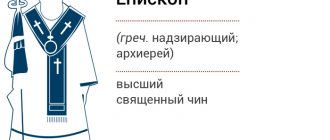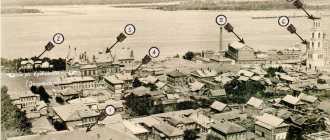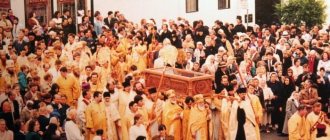Cathedral of the Transfiguration of the Lord in Novosibirsk
The Rosary is a combination of verbal and mental prayer performed with the help of the rosary: we reflect on the main events of the life of Jesus and Mary and draw instruction from them, and to the reflection on each event we add the verbal prayers “Our Father”, “Hail Mary”, “ Glory to the Father” and special prayer exclamations.
The entire Rosary covers 20 events, or mysteries, of which 5 joyful - from the events in the childhood of Jesus Christ, 5 bright - about His feat of gradual ascension to the Cross, 5 sorrowful - relating to His suffering and death, and 5 glorious - reminiscent of the eternal glory of Jesus and Mary in heaven. Thus, the Rosary is divided into 4 parts , each of which contains five topics for meditation, called “secrets”.
Usually one part of the Rosary is recited daily. In October, the month of the Holy Rosary, all parts are read in succession; On the 1st - the first part, on the 2nd - the second, on the 3rd - the third, on the 4th - the fourth, on the 5th - the first again, etc. In other months, the first part is read on Monday and Saturday, the third part on Tuesday and Friday, the fourth part on Wednesday, and the second part of the Rosary on Thursday. On Sunday, the part that corresponds to the period of the church year is read: during Advent and during the Christmas period - the first, during Great Lent - the third, in all other periods of the year - the fourth.
Part I – Joyful Mysteries (Monday, Saturday)
- Annunciation (Luke 1:26-38) .
- Mary visits Elizabeth (Luke 1:39-45) .
- The Nativity of Jesus Christ (Luke 2:1-14) .
- Presentation (dedication of Jesus to God in the temple - Luke 2:22-40) .
- The twelve-year-old boy Jesus is found in the temple (Luke 2:41-52) .
Part II – Bright secrets (Thursday)
- Baptism of Jesus in the Jordan (Matt 3:17)
- Miracle at Cana of Galilee (John 2.1)
- Preaching the Kingdom of God and the call to repentance (Luke 17.21)
- Transfiguration on Mount Tabor (Matthew 17.2)
- Institution of the Eucharist (Eph 2.13)
Part III – Sorrowful secrets (Tuesday, Friday)
- Prayer of Jesus in the Garden of Gethsemane (Luke 22:39-46)
- The scourging of Jesus (Luke 23:17-25)
- Crowning with thorns (John 19:2-6) .
- Way of the Cross of Jesus Christ (Luke 23:26-32).
- The crucifixion of Jesus Christ (Luke 23:33-46).
Part IV – Glorious Mysteries (Wednesday, Sunday)
- Resurrection of Jesus Christ (Mark 16:1-14).
- The Ascension of Jesus Christ into heaven (Mark 16:15-20; Acts 1:14-2, 11).
- Descent of the Holy Spirit. (Mt 28:19)
- Dormition of the Theotokos (Assumption of the Blessed Virgin Mary into heaven - Luke 1:46-55) .
- Crowning of the Virgin Mary with heavenly glory (Rev 12:1-10) .
ORDER OF READING THE ROSARY
The sign of the cross is made, the cross on the rosary is kissed, and the opening prayer of the Rosary is recited:
Our Lord Jesus Christ! I dedicate to You this holy Rosary for the glory of Your name, in honor of Your Most Pure Mother and for the salvation of souls.
First, take the cross with your fingers and read “I Believe.” Then the first bead is taken and “Our Father” is read. On the next three – 3 times “Hail Mary” (we ask for an increase in faith, hope and love), 1 time – “Glory to the Father”.
After this, the name of the part and the first secret is announced (you can read the text of the Gospel, which is indicated after the secret). The large bead reads “Our Father,” and the small beads read 10 “Hail Marys.” At the end of each mystery, “Glory to the Father” is said and prayer exclamations are added:
O Mary, conceived without original sin! Pray to God for us who come running to You.
O my Jesus, forgive us our sins, deliver us from the fire of hell and bring all souls to heaven, especially those who are most in need of Your mercy.
At the end of praying the Rosary, you can say the prayer “Under Your Protection” or another antiphon to the Blessed Virgin Mary.
Prayer after the Rosary
God, Your Only Begotten Son, through His life, death and resurrection, opened for us the path to eternal salvation. We pray to You: grant that, by meditating on these mysteries in the Holy Rosary of the Blessed Virgin Mary, we will follow the examples taught there and be rewarded with the fulfillment of the promises given to us. Through Christ our Lord. Amen.
At the end of the daily prayer of the Rosary, the Litany of the Blessed Virgin Mary .
Let's read the Rosary together!
October in the Catholic Church is dedicated to praying the Holy Rosary. From October 1, in every church (usually before Mass), believers gather for this prayer, and priests also encourage people to pray the Rosary in the family circle. By asking together for the intercession of the Blessed Virgin Mary, the family has the opportunity to unite spiritually and receive God's grace.
The first mentions of the use of rosary prayers similar to the Rosary in Christian monasteries date back to the 9th century. Initially, 150 psalms of the Psalter were read on 150 beads of the rosary, and only later the circle was divided into tens, separated by large beads, and instead of psalms, the Lord’s Prayer was read on a large bead, and a Hail Mary on each small bead. The rosary acquired its modern appearance in the 13th century. Catholic tradition refers in this regard to the appearance of the Virgin Mary to Saint Dominic in 1214. It is the Dominican Order that bears special credit for the spread of the Rosary prayer among wide circles of believers in the 15th century, but a significant role in this regard also belongs to the Franciscan and Jesuit Orders. Tradition connects the prayer of the Rosary with the victory of Catholic Europe over the Turks at Lepanto, in memory of which the feast of the Virgin Mary, Queen of the Rosary (October 7) was established by St. Pope Pius V. The Blessed Virgin Mary, in Her officially recognized Church apparitions at Lourdes (1858) and Fatima (1917), confirmed the need to read the Rosary.
The classic rosary for the Rosary consists of five sets of ten small beads and one large enclosed in a ring, as well as three small beads, one large bead, a crucifix (cross) and a medallion. The prayer of the Rosary, recited on the rosary, is an alternation of the prayers Our Father, Hail Mary and Glory, which should be accompanied by reflections on the mysteries that correspond to certain gospel events.
Whenever evil grew stronger, the Catholic Church fervently and resolutely called people to pray the Rosary, brought to her through the Virgin Mary as a remedy against evil. If the machinations of the spirits of evil in high places and the attacks of dishonest people intensify, the zeal of the righteous must increase and become more and more unyielding. The Rosary is an extraordinarily effective remedy not only for social evils, but also for the evils that are present within ourselves. But here the question arises, how should one pray in order to achieve blessed spiritual results?
Both children and adults pray on the rosary-rosary; those just beginning to comprehend the science of prayer and great mystics; simple believers and theologians. The Rosary is a wonderfully flexible prayer. There are many hidden possibilities in this simple prayer. Here we will name only the most basic ones.
The Rosary is intended primarily as a meditation on the great mysteries revealed by God in the Gospel. We reflect on them together with the Virgin Mary and in Her spirit. This is why the Rosary is sometimes called the “Gospel of Christ of Mary.” While reciting the first ten of the Joyful Part, someone, for example, can imagine the Mother of God in Nazareth at the moment when the Archangel Gabriel visited Her, and thereby become a witness to the dialogue of Heaven with earthly humanity.
The Rosary can also be perceived as an oral prayer with an unusually rich meaning. “Our Father...” is, first of all, the prayer that the Savior taught us. Its depth is the depth of the Heart of Christ. Thinking about her words opens up more and more new meanings for us. The first part of the Annunciation is the words of the Angel addressed to Mary; the next part is Elizabeth’s words. Next comes a prayer addressed on behalf of the Church to the Mother of God. In it is the hope that She, the Mother of God, will pray for us sinners, now and at the hour of our death. We have at our disposal a text of outstanding merit. We do not need to look for our own words, we take only the prayer of the Church and let it guide us. By saying it, we join a huge community of believers who have prayed these same words for centuries.
You can pray on the rosary-rosary and in a contemplative way . Some would like not just to think about Jesus and Mary, but to be with Them in love or to feel safe next to the Heavenly Mother.
Finally, the Rosary can become an intercessory prayer . It happens that one of our loved ones experiences a burning need for support, or we ourselves begin to understand more clearly the needs of the Church and the whole world, remembering wars, persecution, and prevailing evil. We develop an inner conviction of the need for urgent prayer for world peace or another equally important intention. We could simply say, “God help these people,” but such a prayer would be too short, too easy, and too uncommittal. The Rosary allows us to be patient in prayer. By saying a dozen or a whole part of the Rosary, we show God that we consider this prayer very significant and are ready to spend as much of our time for it as necessary.
***
The Rosary prayer contains a brief retelling of the main events of the Gospel, which, thanks to its simple form, allows us to experience the main Christian mysteries. Together with Mary, the Disciple of Christ, filled with the Spirit of God, through the recitation of the Rosary we contemplate the Divine Face of Christ. We want to be like Jesus and embody the values of the gospel in our lives. Despite the fact that the main prayer of the Rosary - “Hail Mary” - is addressed to the Blessed Virgin, its center and peak is the word “Jesus” and the Person of Jesus Himself, to Whom all our feelings and all our attention are directed.
The full circle of the Rosary consists of four parts - joyful, bright, sorrowful and glorious mysteries. Each part includes five events from the life of Christ and the Virgin Mary.
Sequence of the Rosary
As we begin the Rosary, we pray like this:
In the name of the Father and the Son and the Holy Spirit. Amen.
We touch the crucifix (cross) at the end of the rosary with our fingers and read the Apostle’s Creed, briefly reproducing the basic truths of our Salvation.
On the first large bead we read “Our Father,” on each of the next three small beads we read “Hail Mary” (so that faith, hope and love may increase in us), and finally, “Glory to the Father.”
This concludes the introductory part to the Rosary.
Subsequently, touching the next large bead, we pronounce the name of the corresponding part and mystery (for example, “The Third Joyful Mystery. The Nativity of Our Lord Jesus Christ”), then we read the prayer “Our Father”, and on the small beads 10 times - “Hail Mary ”, and at the end of the mystery - “Glory to the Father.”
After each next secret, you can add the following prayer appeals:
O Mary, conceived without original sin, pray to God for us who come running to You!
Oh my Jesus! Forgive us our sins, deliver us from the fire of hell, bring all souls to heaven, and especially those who most need Your mercy.
At the end of praying the Rosary, you can read the Litany of the Blessed Virgin Mary and say the prayer “Under Your Protection” or another antiphon to the Blessed Virgin Mary.
Joyful Mysteries (on Mondays and Saturdays): 1. Annunciation 2. Visit of the Blessed Virgin Mary to Saint Elizabeth 3. Nativity of Jesus Christ 4. Presentation of the Lord 5. Finding of the Child Jesus in the Temple
Bright mysteries (on Thursdays): 1. Baptism of the Lord 2. Marriage in Cana of Galilee 3. Proclamation of the Kingdom of God and a call to conversion 4. Transfiguration of the Lord 5. Last Supper
Sorrowful mysteries (on Tuesdays and Fridays): 1. The Prayer of Jesus Christ in the Garden of Gethsemane 2. The Flagellation of Jesus Christ 3. The Crowning with Thorns 4. The Way of the Cross of Jesus Christ 5. The Crucifixion and Death of Jesus Christ
Glorious Mysteries (on Wednesdays and Sundays): 1. Resurrection of Jesus Christ 2. Ascension of Jesus Christ 3. Descent of the Holy Spirit 4. Dormition of the Blessed Virgin Mary 5. Crowning of the Blessed Virgin Mary with heavenly glory
As an introduction to the next mystery of the Rosary, you can read or sing a hymn suitable in content or read a passage from the Gospel, after which you can reflect for several minutes in silence on its spiritual content.
Joyful Mysteries: 1. Annunciation: Luke 1, 26-38 2. Visit of the Blessed Virgin Mary to Saint Elizabeth: Luke 1, 39-45 3. Nativity of Jesus Christ: Luke 2, 1-19 4. Presentation of the Lord: Luke 2, 22-35 5. Finding of the Child Jesus in the Temple: Luke 2:42-51
Bright mysteries: 1. Baptism of the Lord: Matthew 3 2. Marriage in Cana of Galilee: John 2, 1-11 3. Proclamation of the Kingdom of God and the call to conversion: Matthew 5, 1-16; 7, 24-29 4. Transfiguration of the Lord: Matthew 17, 1-13 5. Last Supper: John 13, 1-5. 12-17; Matthew 26, 26-30
Sorrowful mysteries: 1. Prayer of Jesus Christ in the Garden of Gethsemane: Matthew 26, 36-44 2. The flagellation of Jesus Christ: Luke 23, 13-23; John 19, 1 3. Crowning with thorns: John 19, 2-11. 14b-15a 4. Way of the Cross of Jesus Christ: Luke 23, 26-28. 32-38 5. Crucifixion and death of Jesus Christ: John 19, 23-27; Luke 23:44-49
Glorious mysteries: 1. Resurrection of Jesus Christ: Matthew 28, 1-10 2. Ascension of Jesus Christ: Matthew 28, 16-20; Acts 1, 8-9 3. The Descent of the Holy Spirit: Acts 2, 1-4 4. Assumption of the Blessed Virgin Mary: John 14, 1-4. 6b 5. Crowning of the Blessed Virgin Mary with heavenly glory: Eph 1:3-10
Based on materials from katolik-gomel.by
The author of the bottom photo is Anastasia Podlinyaeva
October. Why and how to pray the Rosary?
On October 1, the Catholic Church begins the month of praying the Rosary. This prayer is performed every day after Holy Mass, and the priests also encourage people to pray the rosary in their homes: with their families, with their children, to read at least one ten rosaries every evening. However, many believe that this is an outdated activity that is only needed by religious grandmothers who are used to praying like this...
Let's start with the help. The first mentions of the use of rosary prayers similar to the Rosary in Christian monasteries date back to the 9th century. Initially, 150 psalms of the Psalter were read on 150 beads of the rosary, and only later the circle was divided into tens, separated by large beads, and instead of psalms, the Lord’s Prayer and Ave Maria were read on it. The rosary acquired its modern appearance in the 13th century. Catholic tradition officially connects their appearance with the appearance of the Virgin Mary to Saint Dominic in 1214. The Dominican Order played a special role in the spread of the Rosary in the 15th century. It is with this prayer that tradition connects the victory of Catholic Europe over the Turks at Lepanto, in memory of which the feast of the Virgin Mary, Queen of the Rosary (October 7) was established. According to Catholic teaching, the Virgin Mary, in her apparitions at Lourdes (1858) and Fatima (1917), confirmed the need to recite the Rosary.
The classic rosary for the Rosary consists of 5 sets of ten small beads and one large, enclosed in a ring, as well as three small, one large bead, a crucifix (cross) and a medallion. The prayer of the Rosary, recited on the rosary, is an alternation of the prayers Our Father, Hail Mary and Glory, which should be accompanied by reflections on the mysteries that correspond to certain gospel events.
Whenever evil grew stronger, the Catholic Church fervently and decisively called people to pray the rosary, given to her through the Virgin Mary as a medicine against evil.
When evil and the attacks of the dishonest increase, the zeal of the righteous must increase and become more tenacious. The Rosary is an extremely effective remedy not only for social evils, but also for the evils that exist within ourselves. The question arises as to how to pray in order to achieve the blessed results of this prayer.
Children and adults, beginners in the science of prayer and great mystics, simple people and theologians pray on the rosary-rosary. The Rosary is a wonderfully flexible prayer. There are many hidden possibilities in this simple prayer. Let's name the main ones.
The Rosary is intended primarily as a meditation on the great mysteries declared by God in the Gospels. We reflect on them with Mary and in her spirit. This is why the Rosary is sometimes called the Gospel of Christ of Mary. While reciting the first ten joyful parts, someone, for example, can imagine the Mother of God in Nazareth when the Archangel Gabriel visited her, and thus become a witness to the dialogue between Heaven and earth.
The Rosary can also be perceived as an oral prayer with an unusually rich meaning. “Our Father...” is, first of all, the prayer that the Savior taught us. Its depth is the depth of the Heart of Christ. Reasoning over her words always reveals new meaning to us. The first part of the Annunciation is the words of the Angel addressed to Mary; the next part is Elizabeth’s words. Next comes a prayer directed through the Church to the Mother of God. In it is the hope that She, the Mother of God, will pray for us sinners, now and at the hour of our death. Excellent text at our service. We do not need to look for our own words, we take only the prayer of the Church and let it guide us. By saying it, we join a huge community of believers who have prayed these same words for centuries.
You can pray on the rosary-rosary and in a contemplative way . Some would like not just to think about Jesus and Mary, but to be with Them in love or to feel safe next to the Heavenly Mother.
The rosary can also become a prayer of intercession . It happens that one of our loved ones feels a great need for support, or we ourselves begin to understand more clearly the needs of the Church and the whole world: we think about wars, persecution, prevailing evil. We feel that we must sincerely pray for peace to reign. We could simply say, “God help these people,” but such a prayer would be too short, too easy. The Rosary allows you to be patient in prayer. By saying a dozen or a whole part of the Rosary, we show God that we consider this prayer significant and are ready to sacrifice time for it.
The Rosary prayer contains a brief retelling of the main events of the Gospel, which, thanks to its simple form, allows us to experience the main Christian mysteries. Together with Mary, the Disciple of Christ, filled with the Spirit of God, through the recitation of the Rosary we contemplate the Divine Face of Christ. We want to be like Jesus and embody the values of the gospel in our lives. Despite the fact that the main prayer of the Rosary - “Hail Mary” - is addressed to the Blessed Virgin, its center and peak is the word Jesus, to whom all our feelings and all our attention are directed.
The prayer consists of four parts - joyful, bright, sorrowful and glorious mysteries. Each part includes five events from the life of Christ and the Virgin Mary.
Sequence of praying the Rosary Starting the Rosary, we pray like this:
In the name of the Father, and the Son, and the Holy Spirit. Amen.
"I believe in God"
"Our Father"
3 times "Hail Mary"
"Glory to the Father"
We begin each mystery of the Rosary by saying the name of the corresponding part and mystery, then the prayer “Our Father,” then “Hail Mary” 10 times and, at the end of the mystery, “Glory to the Father.”
After each secret you can read:
Oh my Jesus! Forgive us our sins, deliver us from the fire of hell and bring all souls to heaven, especially those who most need Your mercy.
At the end of praying the Rosary, you can say the prayer “Under Your Protection” or another antiphon to the Blessed Virgin Mary.
Joyful Mysteries (on Mondays and Saturdays): 1. Annunciation 2. Visit of the Most Holy Theotokos to St. Elizabeth 3. Nativity of Christ 4. Presentation of the Lord 5. Finding of the Child Jesus in the Temple
Bright mysteries (on Thursdays): 1. Baptism of the Lord 2. Marriage in Cana of Galilee 3. Proclamation of the Kingdom of God and a call to conversion 4. Transfiguration of the Lord 5. Last Supper
Sorrowful mysteries (on Tuesdays and Fridays): 1. The Prayer of Jesus Christ in the Garden of Gethsemane 2. The Flagellation of Jesus Christ 3. The Crowning with Thorns 4. The Way of the Cross of Jesus Christ 5. The Crucifixion and Death of Jesus Christ
Glorious Mysteries (on Wednesdays and Sundays): 1. Resurrection of Jesus Christ 2. Ascension of Jesus Christ 3. Descent of the Holy Spirit 4. Dormition of the Blessed Virgin Mary 5. Crowning of the Blessed Virgin Mary with heavenly glory
As an introduction to each mystery of the Rosary, you can sing the corresponding song or read a passage from the Bible and meditate on its mystery.
Joyful Mysteries: 1. Annunciation: Luke 1, 26-38 2. Visit of the Blessed Virgin Mary to Saint Elizabeth: Luke 1, 39-45 3. Nativity of Christ: Luke 2, 1-19 4. Presentation of the Lord: Luke 2, 22-35 5 Finding of the Child Jesus in the Temple: Luke 2:42-51
Bright mysteries: 1. Baptism of the Lord: Matthew 3 2. Marriage in Cana of Galilee: John 2, 1-11 3. Proclamation of the Kingdom of God and the call to conversion: Matthew 5, 1-16; 7, 24-29 4. Transfiguration of the Lord: Matthew 17, 1-13 5. Last Supper: John 13, 1-5. 12-17; Matthew 26, 26-30
Sorrowful mysteries: 1. Prayer of Jesus Christ in the Garden of Gethsemane: Matthew 26, 36-44 2. The flagellation of Jesus Christ: Luke 23, 13-23; John 19, 1 3. Crowning with thorns: John 19, 2-11. 14b-15a 4. Way of the Cross of Jesus Christ: Luke 23, 26-28. 32-38 5. Crucifixion and death of Jesus Christ: John 19, 23-27; Luke 23:44-49
Glorious mysteries: 1. Resurrection of Jesus Christ: Matthew 28, 1-10 2. Ascension of Jesus Christ: Matthew 28, 16-20; Acts 1, 8-9 3. The Descent of the Holy Spirit: Acts 2, 1-4 4. Assumption of the Blessed Virgin Mary: John 14, 1-4. 6b 5. Crowning of the Blessed Virgin Mary with heavenly glory: Eph 1:3-10
How to recite the Rosary using the rosary
First, take the cross with your fingers and read “I believe in God...”. This is the “Creed,” which in brief form contains the truth revealed to us by God about Himself, about how He came to earth, lived on it, died and rose again, so that we could join Him at the end of earthly life. life ascend to Heaven..
Then the first bead is taken and “Our Father...” is read. On the next three - three times “Hail Mary...” (to increase faith, hope and love). After that - “Glory to the Father...”.
These prayers form the introduction to the Rosary.
After this, the name of the part and the first secret is announced. On the large bead one reads “Our Father...”, on the small ones - 10 “Hail Mary...”. At the end of each mystery, “Glory to the Father...” is said and prayer exclamations can be added:
“Oh my Jesus! Forgive us our sins, deliver us from the fire of hell and bring all souls to heaven, especially those who most need Your Mercy.”
“O Mary, conceived without original sin! Pray to God for us who come running to You.”
The article uses materials from Wikipedia and the magazine “Love Each Other”.
Luminous mysteries of the Holy Rosary
Bright secrets
On October 16, 2002, in the Apostolic Letter on the Rosary of the Virgin Mary
(Rosarium Virginis Mariae),
John Paul II included a new part of it in the Holy Rosary: the bright mysteries associated with the public life of Christ - from His Baptism in the Jordan to the Passion: 1) The Baptism of Jesus Christ in Jordan;
2) His Revelation of Himself at the wedding feast in Cana; 3) Proclamation of the Kingdom of God and a call to conversion; 4) His Transfiguration; 5) The establishment of the Eucharist - the sacramental embodiment of the Paschal Mystery. The Pope advises to penetrate these mysteries with faith and heart on Thursdays. In his document, John Paul II declared 2002 the Year of the Rosary.
1. Baptism of Jesus in the Jordan“The first luminous mystery is the Baptism of Jesus in the Jordan, during which, when Christ is immersed in the waters of the river, the Innocent One became “sin” for us (cf. 2 Cor 5:21)
- the heavens open and the voice of the Father calls Him the Beloved Son
(see Matthew 3:17 ff.)
, and the Holy Spirit descends on Him and calls Him to a future mission.”
( Rosary of the Virgin Mary, 21)
“The Baptism of Jesus, on His part, is the acceptance and beginning of His mission as a suffering Servant. He allows Himself to be counted among sinners; He is already “the Lamb of God who takes away the sin of the world” (John 1:29);
He already foreshadows the “baptism” of His bloody death. He already comes “to fulfill all righteousness” (Matthew 3:15
), that is, he completely submits to the will of the Father: out of love He agrees to this baptism of death for the remission of our sins.
This acceptance is answered by the voice of the Father, announcing that all His good pleasure is in the Son. The Spirit, which Jesus possessed in its entirety from the moment of His conception, “descends” upon Him (John 1:32-33)
.
Jesus will be the source of the Spirit for all mankind. At His baptism, “the heavens were opened” (Matthew 3:16)
, closed by Adam’s sin;
and the waters were sanctified by the descent of Jesus and the Spirit—this is the introduction to the new creation.” (Catechism of the Catholic Church, 536)
2. Miracle at Cana of GalileeThe miracle at Cana of Galilee is “the beginning of the signs at Cana (see John 2:1-12), when Christ, having turned water into wine, opens the hearts of the disciples to faith, through the intercession of Mary, the first of the believers.” ( Rosary of the Virgin Mary, 21)
3. Preaching the Kingdom of God and calling to repentance
The third luminous mystery is “the sermon of Jesus, in which He announces the approach of the Kingdom of God and calls for conversion (see Mark 1:15)
, remitting the sins of those who approach Him with humble hope
(see Mark 2:3-13; Luke 7:47-48)
- this is the beginning of the ministry of mercy that He will perform until the end of the world, especially through the Sacrament of Reconciliation, entrusted by Him to His Church
(see John 20:22-23)
.”
(Rose of the Virgin Mary, 21)
- “The Kingdom of God has come near”“After John was betrayed, Jesus came to Galilee, preaching the gospel of the kingdom of God and saying that the time is fulfilled and the kingdom of God is at hand: repent and believe in the gospel” (Mark 1:14-15).
“Christ, in order to fulfill the will of the Father, laid the foundation for the Kingdom of Heaven on earth.”
And the will of the Father is “to elevate people to participate in the Divine life.” He does this by gathering people around His Son Jesus Christ. This meeting is the Church on earth - the “germ and beginning” of the Kingdom of God.” (Catechism of the Catholic Church, 541)
“Christ is at the center of this gathering of people into the “family of God.” He calls them to Himself with words, signs that reveal the Kingdom of God, and also by sending His disciples to them. He will bring about the coming of His Kingdom primarily through the great mystery of His Easter: the death of the cross and resurrection. “And when I am lifted up from the earth, I will draw everyone to Me” (John 12:32).
All people are called to this union with Christ.” (Catechism of the Catholic Church, 542)
- All people are called to enter the Kingdom of God.“Announced first to the children of Israel, this messianic kingdom is destined to welcome people from all corners of the world. To gain access to it, one must accept the word of Christ" (Catechism of the Catholic Church, 543)
— The Kingdom of God belongs to the poor and small
“The Kingdom of Heaven belongs to the poor and small, that is, to those who accepted it with a humble heart. Jesus was sent to “preach good news to the poor” (Luke 4:18)
.
He declares them blessed, “for theirs is the kingdom of heaven” (Matt 5:3)
;
The Father deigned to reveal to the “babes” what remained hidden from the wise and prudent.” Jesus shares the lives of the poor - from the manger to the crucifixion; He knows hunger, thirst and hardship. Moreover, He identifies Himself with all kinds of poor people and makes active love for them a condition for entry into His Kingdom.” (Catechism of the Catholic Church, 544)
- Also sinners are called to the Kingdom of God“Jesus invites sinners to the feast of the Kingdom: “I came not to call the righteous, but sinners” (Mark 2:17)
.
He calls them to conversion, without which it is impossible to enter the Kingdom of Heaven, but in words and deeds he shows them the Father’s boundless mercy towards them and immeasurable joy in heaven “for one sinner who repents” (Luke 15:7)
.
The highest proof of this love will be His sacrificing His life “for the remission of sins” (Matthew 26:28)
.
(Catechism of the Catholic Church, 545)
- Parables about the Kingdom of Heaven“In calling to enter the Kingdom of Heaven, Jesus resorts to parables, and this is a characteristic feature of His teaching. In parables, He invites you to the feast of the Kingdom of Heaven, but at the same time invites you to make a radical choice: in order to receive the Kingdom of Heaven, you must give everything; Words are not enough - actions are needed. For a person, parables are like mirrors, showing whether he accepts the word of Christ - like rocky places or like good soil. What does he do with the talents he receives? Jesus and the presence of the Kingdom of Heaven in this world are at the heart of the parables. You need to enter the Kingdom of Heaven, that is, become a disciple of Christ, in order to “know the secrets of the Kingdom of Heaven” (Matthew 13:11)
.
For those “outside ” (Mark 4:11)
, everything remains mysterious."
(Catechism of the Catholic Church, 546)
- Signs of the Kingdom of God“Jesus accompanies His words with numerous “powers and wonders and signs” ( Acts 2:22)
which show that the Kingdom of Heaven is in Him.
They confirm that Jesus is the proclaimed Messiah.” (Catechism of the Catholic Church, 547)
“The signs of Jesus testify that the Father sent him. They call to believe in Him. To those who turn to Him in faith, He gives what they ask. Then miracles strengthen faith in the One who fulfills the works of His Father: they testify that He is the Son of God. But they can also be a reason to be “offended” (Mt 11:6).
They are not aimed at satisfying curiosity and thirst for the miraculous. Despite such obvious miracles, there are people who reject Jesus; He is even accused of acting with demonic power.” (Catechism of the Catholic Church, 548)
“By liberating some people from earthly evils - hunger, injustice, disease and death, Jesus showed messianic signs; However, He came not to abolish all earthly suffering, but to deliver people from the most severe slavery - enslavement to sin, which prevents them from their calling as sons of God and gives rise to all other types of human enslavement.” (Catechism of the Catholic Church, 549)— The coming of the Kingdom of God is the defeat of the kingdom of Satan
“If I cast out demons by the Spirit of God, then the kingdom of God has certainly come upon you” (Matthew 12:28)
.
Jesus casting out demons frees people from their power4. It foreshadows the great victory of Jesus over “the prince of this world” (John 12:31). By the Cross of Christ the Kingdom of God will be finally established: “God reigns from the tree.” (Catechism of the Catholic Church, 550)
- "Keys of the Kingdom of Heaven"“From the very beginning of His public ministry, Jesus chose people, twelve in number, to be with Him and share in His mission. He gives them a share in His authority. He “sent them out to preach the kingdom of God and to heal the sick” (Luke 9:2)
.
They forever remain in communion with the Kingdom of Christ, for Christ rules the Church through them: And I bequeath to you, as My Father bequeathed to Me, a kingdom, that you may eat and drink at My table in My kingdom, and sit on thrones judging the twelve tribes of Israel (Luke 22.29-30)
.”
(Catechism of the Catholic Church, 551)
“In the assembly of the Twelve, Simon Peter occupies first place. Jesus entrusted him with a special mission. Thanks to the Revelation received from the Father, Peter confessed: “You are the Christ, the Son of the living God.” In response to this, our Lord said: “You are Peter, and on this rock I will build My Church, and the gates of hell will not prevail against it” (Matthew 16:18).
Christ, the “living stone” (1 Peter 2:4)
, gives His Church, built on the stone Peter, certain victory over the forces of death.
By virtue of his confessed faith, Peter will be an indestructible rock - the support of the Church. His mission will be to preserve this faith from impoverishment and strengthen his brothers in it.” (Catechism of the Catholic Church, 552)
“Jesus gave Peter a specific authority: “And I will give you the keys of the kingdom of heaven; and whatever you bind on earth will be bound in heaven; and whatever you loose on earth will be loosed in heaven" (Matthew 16:19).
“The authority of the keys” is the definition of the right to govern the House of God, which is the Church. Jesus, the “good Shepherd” (John 10:11)
, confirmed this assignment after the Resurrection: “Feed My sheep”
(John 21:15-17)
.
The power to “bind” and “loose” means the authority to absolve sins, make doctrinal judgments, and make disciplinary decisions in the Church. Jesus entrusted this authority to the Church through the ministry of the apostles and above all Peter, the only one to whom He directly entrusted the keys of the Kingdom of Heaven.” (Catechism of the Catholic Church, 553)
- This kingdom will have no end“The fact that Jesus is seated at the right hand of the Father signifies the coming of the Kingdom of the Messiah, the fulfillment of the prophet Daniel’s vision of the Son of Man: “And to Him was given authority, glory and a kingdom, that all nations, tribes and languages should serve Him; His dominion is an everlasting dominion, which will not pass away, and His kingdom will not be destroyed" (Dan 7:14)
.
From then on, the apostles became witnesses of “His Kingdom,” which “will have no end.” (Catechism of the Catholic Church, 664)
“Jesus Christ, the Head of the Church, precedes us in the glorious Kingdom of the Father, so that we, members of His body, may live in the hope of one day being with Him forever.” (Catechism of the Catholic Church, 666)— The future fullness of the Kingdom of God
“Already present in His Church, the Kingdom of Christ, however, has not yet been accomplished “with power and great glory” (Luke 21:27)
the coming of the King to earth.
This Kingdom is still being attacked by the forces of lawlessness, even if they have already been fundamentally defeated by the Passover of Christ. Until all things are subject to Him, “until there are new heavens and a new earth in which righteousness dwells, the itinerant Church, in her sacraments and in the institutions that belong to this age, bears the transitory image of this world; she lives among creatures who are still groaning in birth pangs and awaiting the revelation of the sons of God.” Therefore, Christians pray, especially when celebrating the Eucharist, that Christ will soon return: “Come, Lord!” (1 Cor 16:22; Rev 22:17.20)
".
(Catechism of the Catholic Church, 671)
4. Transfiguration on Mount Tabor“Transfiguration is a bright mystery in the full sense of the word; according to Tradition, it happened on Mount Tabor. Divine glory shines on the Face of Christ, meanwhile the Father calls the Apostles, who are in ecstasy, to listen to His Son (cf. Lk 9:35)
and prepares them to experience with Him the agony of the Passion and to enter with Him into the joy of the Resurrection and into life transformed by the Holy Spirit.”
(Rose of the Virgin Mary, 21)
5. Establishment of the Sacrament of the Eucharist“The last bright mystery is the institution of the Eucharist, in which Christ, under the guise of bread and wine, gives Himself, His Body and Blood, “as food” and “to the end” testifies to His love for humanity (cf. John 13:1), for the sake of salvation whom He will soon sacrifice Himself." (Rose of the Virgin Mary, 21)
Prayers before and after the Rosary
Opening Prayer:
Our Lord Jesus Christ! I dedicate this Holy Rosary to You for the glory of Your name, in honor of Your Most Pure Mother and for the salvation of souls.
Closing prayer:
God, Your Only Begotten Son, through His life, death and resurrection, opened for us the path to eternal salvation. We pray to You: grant that, as we meditate on these mysteries in the Holy Rosary of the Blessed Virgin Mary, we will follow the examples taught there and be rewarded with the fulfillment of the promises given to us. Through Christ our Lord. Amen.
Secrets of the Rosary
As an introduction to each mystery of the Rosary, you can read the corresponding passage from the Bible and reflect on its mystery - see Meditations .
Part One: Joyful Mysteries
- Annunciation
- Visit of the Blessed Virgin Mary to Saint Elizabeth
- Nativity
- Presentation of the Lord
- Finding of the Child Jesus in the Temple
Part two: Bright secrets
- Baptism of Jesus in Jordan
- Miracle at Cana of Galilee
- Preaching the Kingdom of God and a call to repentance
- Transfiguration
- Establishment of the Sacrament of the Eucharist
Part Three: Sorrowful Secrets
- Jesus Prayer in the Garden of Gethsemane
- Flagellation
- Crowning with thorns
- Way of the Cross
- Crucifixion and death of Jesus Christ
Part Four: Glorious Mysteries
- Resurrection of Jesus Christ
- Ascension of Jesus Christ
- Descent of the Holy Spirit
- Dormition of the Blessed Virgin Mary
- Crowning of the Blessed Virgin Mary with heavenly glory
Prayers
ROSARY FIRST PART THE JOYFUL MYSTERIES
- Annunciation.
- Mary visits Elizabeth.
- Nativity of Jesus Christ.
- Presentation (dedication of Jesus to God in the temple).
- The twelve-year-old boy Jesus is found in the temple.
SECOND PART MOURNING SECRETS
- Prayer of Jesus in the Garden of Gethsemane.
- The scourging of Jesus.
- Crowning with thorns.
- Way of the Cross of Jesus Christ.
- Crucifixion of Jesus Christ.
PART THREE GLORIOUS MYSTERIES
- Resurrection of Jesus Christ.
- The Ascension of Jesus Christ to Heaven.
- Descent of the Holy Spirit.
- Dormition of the Theotokos (Assumption of the Blessed Virgin Mary into heaven).
- Crowning of the Virgin Mary with heavenly glory.
Usually one part of the Rosary is read daily. In October - the month of the Holy Rosary - all parts are read in a row: on the 1st - the first part, on the 2nd - the second, on the 3rd - the third, on the 4th - the first again, etc. In other months, the first part is read on Monday and Thursday, the second on Tuesday and Friday, and the third on Wednesday and Saturday. On Sunday, the part that corresponds to the period of the church year is read: during Advent and during the Christmas period - the first, during Great Lent - the second, in all other periods of the year - the third.
ORDER OF READING THE ROSARY:
The sign of the cross is made, the cross on the rosary is kissed, and the opening prayer of the Rosary is recited:
Our Lord Jesus Christ! I dedicate to You this holy Rosary for the glory of Your name, in honor of Your Most Pure Mother and for the salvation of souls.
First, take the cross with your fingers and read “I Believe.” Then the first bead is taken and “Our Father” is read. On the next three - three times “Hail Mary” (to increase faith, hope and love). After that - “Glory”. These prayers form the introduction to the Rosary.
After this, the name of the part and the first dance is announced. The large bead reads “Our Father,” and the small beads read 10 “Hail Marys.” At the end of each mystery, “Glory” is pronounced and prayer exclamations are added:
O Mary, conceived without original sin! Pray to God for us who come running to You.
Oh my Jesus! Forgive us our sins, deliver us from the fire of hell and bring all souls to heaven, especially those who most need Your mercy.
At the end of the daily prayer of the Rosary, the Litany of the Blessed Virgin Mary is read, as well as the prayer of St. Joseph.
To avoid distraction when reading the Rosary, in each Hail Mary prayer, after the words “blessed is the fruit of your womb, Jesus,” you can mention the mystery about which we are reflecting, for example:
Joyful secrets:
1st mystery:
“...Jesus, whom You conceived of the Holy Spirit.”
2nd mystery:
“...Jesus, with whom you visited Elizabeth.”
3rd mystery:
“...Jesus, whom You gave birth to in Bethlehem.”
4th mystery:
“...Jesus, whom You dedicated to God in the temple.”
5th mystery:
“...Jesus, whom you found in the temple.”
Sad secrets:
1st mystery:
“...Jesus, who prayed in the garden of Gethsemane.”
2nd mystery:
“...Jesus, Who was scourged for us.”
3rd mystery:
"...Jesus, Who was crowned with thorns."
4th mystery:
“...Jesus, who bore a heavy cross for us.”
5th mystery:
“...Jesus, who died for us on the cross.”
Glorious Secrets:
1st mystery:
"...Jesus, who rose from the dead."
2nd mystery:
"...Jesus, who ascended into heaven."
3rd mystery:
“...Jesus, who sent down the Holy Spirit to us.”
4th mystery:
“...Jesus, who took you into heaven.”
5th mystery:
“...Jesus, Who crowned You with heavenly glory.”
Prayer after the Rosary:
God, Your Only Begotten Son, through His life, death and resurrection, opened for us the path to eternal salvation. We pray to You: grant that, by meditating on these mysteries in the Holy Rosary of the Blessed Virgin Mary, we will follow the examples taught there and be rewarded with the fulfillment of the promises given to us. Through Christ our Lord. Amen.
Introduction
The Rosary is a combination of verbal and mental prayer, usually performed using rosaries individually or by a group of believers. This prayer contains a brief retelling of the main events of the Gospel, which, thanks to its simple form, allows us to experience the main Christian mysteries. Through the reading of the Rosary, we, together with Mary, contemplate the Divine Face of the Savior. We reflect on the major events in the lives of Jesus and Mary and draw instruction from them. Although the main prayer of the Rosary - "Hail Mary" - is addressed to the Blessed Virgin, its center and pinnacle is the word "Jesus", to which all our feelings and all our attention are directed.
The prayer consists of four parts, each of which is usually read on certain days of the week: joyful mysteries on Mondays and Saturdays, bright mysteries on Thursdays, sorrowful mysteries on Tuesdays and Fridays, and glorious mysteries on Wednesdays and Sundays. During Advent and during the Christmas period, joyful mysteries are read on Sundays, and sorrowful mysteries are read on Sundays of Great Lent. In October, dedicated to the Holy Rosary, all mysteries are read in a row: on the 1st - the first; 2nd - second; ... On the 5th - first again and so on. The complete Rosary can be recited daily.
The entire Rosary covers 20 events - mysteries - from the life of Christ and the Virgin Mary. The Joyful Mysteries tell us about the incarnation of the Son of God and His life in the Holy Family; light ones - about His public service; the sorrowful plunge us into the suffering and death of the Savior on the cross; finally, the glorious mysteries reveal to us the eternal glory of Jesus and Mary in heaven. Thus, each part of the Rosary contains five topics for prayerful reflection, which are called mysteries.
How to recite the Rosary using the rosary
The sign of the cross is performed “In the name of the Father and the Son and the Holy Spirit. Amen,” the cross on the rosary is kissed and “I Believe” is read. After this, the first large* bead is taken and “Our Father” is read on it. The next three small beads read "Hail Mary" to increase faith, hope and love. The large bead then reads "Glory". This is how the introductory part of the Rosary is performed.
Now the part and the secret should be announced, if such an announcement is intended. For example: “The first joyful mystery. Annunciation". On the large bead (the same one on which "Glory" was just read) the "Our Father" is read, then on each of the ten small "Hail Marys", and on the next large "Glory". This is how the reading of one secret ends. At the end of each mystery, you can add prayer exclamations:
Oh my Jesus! Forgive us our sins, deliver us from the fires of hell and bring all souls to heaven, especially those who most need Your mercy. O Mary, conceived without original sin! Pray for us who come running to You.
After this, the reading of the next secret begins in the same order: announcement (if necessary); large bead - “Our Father”; small ones - “Hail Mary”; the big one is “Glory”.
In every Hail Mary prayer, after the words “blessed is the fruit of your womb, Jesus,” you can mention the mystery about which we reflect - see Reflections .
At the end of the daily prayer of the Rosary, you can read the Litany of the Blessed Virgin Mary with the antiphon “Under Your Protection” (you can do without the litany), as well as the prayer to St. Joseph.
* all beads can be the same size, the only thing that matters is their location.
‹…› For most souls who live in the world, the Rosary is the daily spiritual bread, to take away from them or to take them away from this prayer is to diminish in their minds the gratitude and conscientiousness with which they pray, and in the spiritual realm it is the same even more, much more, considering that the spiritual sphere is superior to the material sphere. In other words, it is as if in material life people were deprived of the bread necessary to support their physical life. Unfortunately, most people are ignorant of religious matters and allow themselves to be tossed wherever the tide takes them. Great responsibility therefore rests with those who are in the service of leading them; and we are all leaders of each other, because we all have a duty to mutually help each other and walk the good path.
Besides what I have already said, it would be good if the prayer of the Rosary were given more of an authentic meaning than has been given so far, rather than simply the “Hail Mary” prayer. All the prayers we say in the Rosary are prayers that form part of the Sacred Liturgy; and more than a prayer directed to the Virgin Mary, it is a prayer directed to God: “Our Father” was given to us by Jesus Christ, who said: “Pray this way: Our Father who art in heaven!...” (Matthew 6 :9); - “Glory to the Father and the Son and the Holy Spirit...” is a hymn sung by the angels sent by God to announce the birth of His Word, God created man; - “Virgin Mother of God, rejoice,” as is quite clear, this is no less than a prayer directed to God: “Virgin Mother of God, rejoice, blessed Mary, the Lord is with you.” I greet you, Mary, because the Lord is with you. These words were undoubtedly dictated by the Father to the Angel when He sent him to earth to greet Mary with these words.
‹…›
Perhaps it would be correct to present the purpose of the missionary movement not only as a fulfillment of the Message of Fatima, but also as a movement of prayer and repentance for peace in the world, in the Church and in the Portuguese overseas provinces. And may Portugal, so devoted to the Eucharist and to the Virgin Mary, be the first nation to realize that the Rosary is not just the Marian prayer, but also the Eucharistic prayer. Therefore, nothing should prevent people from praying before the Blessed Sacrament. As proof of this, the Holy Father Pope Pius XI granted a plenary indulgence to those who pray the Rosary before the Blessed Sacrament, and recently His Holiness Pope Paul VI granted a similar indulgence again.
Thus, it is necessary to pray the Rosary in cities, towns and villages, on the streets, on roads, while traveling or at home, in churches and chapels! This prayer is available to everyone, and everyone can and should pray. There are many who do not go to the liturgical prayer of the Holy Mass every day. If they don't pray the Rosary, what prayers do they pray? And without prayer, who can be saved? - “Watch and pray, so that you do not fall into temptation...”
It is then necessary to pray and pray always.
This means that all our activities and labors must be accompanied by intense spiritual prayer, because it is in prayer that the soul meets God, and in this meeting grace and strength are received, even when prayers are accompanied by distractions. Prayer always cultivates faith in souls, even if it is nothing more than an instant remembrance of the mystery of our Salvation, a reminder of the birth, death and Resurrection of our Savior; and God will let go and forgive those distractions that relate to human weakness, ignorance and pettiness.
A Little Treatise, by the Seer, on the Nature and Recitation of the Rosary: a
collection of excerpts from letters of Sister Lucy written between 1969- 71 Letter to Maria Teresa Coimbra, Dec. 4, 1970.


